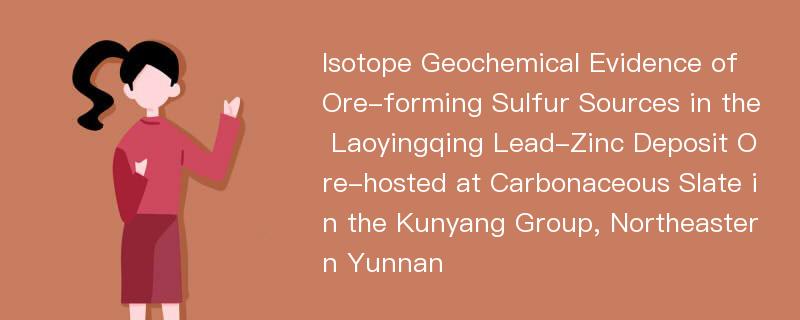
论文摘要
The Northeastern Yunnan Zn-Pb Deposit Concentration District(NEYD), which is in the combination of the SN-trending Xiaojiang deep fault zone and the Zhaotong-Qujing concealed deep fault zone, and the NE-trending Mile-Shizong fault zone and the NW-teending Ziyun-Yadu fault zone, is located in the south-central part of the Sichuan-Yunnan-Guizhou Triangle area(SYGT) in the southwestern margin of the Yangtze Block. In recent years, many scholars have done no less research on ore materials and fluids origins, genesis, and metallogenic mechanism of lead-zinc deposits, and obtained important achievements, but there is still controversy in the ore sources. In this paper, based on the geological conditions of the Laoyingqing lead-zinc deposit, it has found that research on Zn-Pb deposits in SYGT ore-hosted in the Kunyang Group of the middle Proterozoic is less. So ore sources have been discussed by analyzing sulfur isotope characteristics of sphalerite in order to provide a scientific basis for in-depth study on the deposit genesis in NEYD. 1 Deposit geology This deposit is close to the Xiaojiang fault and in the middle of the NNE-trending Dongchuan-Wuxing-Luozehe tectonic belt in NEYD. The structure in the mining area is dominated by the nearly SN-trending Wuxing anticline and secondary NE-and NW-trending faults. The ore-hosted faults F1 and F2 are reverse faults, and their occurrences are 60°∠63° and 115°∠86°.The exposed strata include the Huangcaoling Fm. and the Heishantou Fm. of the Kunyang Group in the Proterozoic, Sinian Dengying Fm. and Quaternary. The Huangcaoling Fm. is mainly silty sand and carbonaceous slate,and the Heishantou Fm. is mainly sandy phyllite,silty slate and siltstone,and the Sinian Dengying Fm. is mainly thick dolomite. The magmatic rocks include the Emeishan basalt and basic diabase veins in the Hercynian period. V1 and V2 ore bodies are hosted in the fault(F1 and F2)zones in the carbonaceous slate at the lower part of the Huangcaoling Fm. of the Kunyang Group in the middle Proterozoic(Pt2h1), and their occurrences are consistent with the faults. These ore bodies are about 302–371 m long, with a thickness of 3.10–3.56 m and a grade of 4.92%–5.26%. The ore bodies are in irregular veins,partially expanded with good continuity. The ores minerals are mainly sphalerite and a small amount of galena and pyrite. The gangue minerals are mainly quartz and calcite, followed by mica, dolomite and Chlorite. The wall rock alterations are mainly silicification and carbonation. 2 Discussion for ore-forming Sulfur Sources Sulfur isotopic composition was completed in Beijing Kehui Testing Technology Co., Ltd. The analysis results show that δ34SV-CDT of sphalerite samples is –1.38‰~–2.62‰, with an average of –1.84‰, which are obviously different from the δ34S values(+9.0‰~+28.6‰)(Kong et al., 2018)of most lead-zinc deposits in SYGT. Ohmoto(1979) pointed out that sulfur source of deposits must be concluded by the total sulfur isotope compos
论文目录
文章来源
类型: 国际会议
作者: GONG Hongsheng,HAN Runsheng,WU Peng
来源: 第九届世界华人地质科学研讨会 2019-06-01
年度: 2019
分类: 基础科学,工程科技Ⅰ辑
专业: 地质学,地质学,矿业工程
单位: Faculty of Land Resources Engineering/Southwest of Geological Survey, Geological Survey Center for Non-ferrous Metals Resources, Kunming University of Science and Technology
分类号: P618.4;P597
DOI: 10.26914/c.cnkihy.2019.028336
页码: 106-107
总页数: 2
文件大小: 153k
下载量: 4
